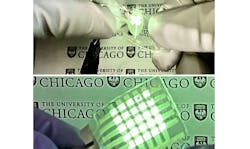A team at the Pritzker School of Molecular Engineering at the University of Chicago (Illinois) has developed a unique organic light-emitting diode (OLED). Ultrathin and stretchable, the material incorporates long polymers with bendable molecular chains and structures that help organic materials emit light. It also uses thermally activated delayed fluorescence, which allows the flexible electroluminescent polymer material to convert electrical energy into light much more efficiently (see video).
The OLED optimizes luminescence and flexibility, says Sihong Wang, an assistant professor of molecular engineering, who co-led the research. It can bend and stretch to more than twice its original length and is unlike the molecular building blocks of conventional OLEDs, which are very brittle with tight chemical bonds and stiff structures.
“We were able to use this thermally activated delayed fluorescence compound, a third-generation organic emitter,” he says. “This design mechanism allows us to achieve the stretchable polymer design.”
Product of inspiration
The growing need for advancement in human interface devices, such as wearables and those that can be implanted, for optical stimulation devices and others to monitor humans’ health statuses was part of the team’s motivation to develop the new material.
“The display is one of the most indispensable components of such devices,” Wang says. “It’s the most important way we receive information from the devices.”
They plan to now incorporate a soft and stretchable elastic form factor into a skin patch that performs like an Apple Watch or wrist-worn Fitbit, but isn’t bulky. Rather, the OLED material could be made into a small sticker that attaches directly onto the skin.
“This will be much less invasive, too,” Wang says. “It would be invisible, imperceptible, and also be much better at collecting all sorts of different weak, subtle types of health-related signals from the human body.”
The creation and commercialization of foldable cell phones served as another inspiration for the researchers. With their stretchable material, “there can now be even more of what I call a ubiquitous use of displays on almost any arbitrary object, like curved things, curved surfaces, or even on irregular surfaces,” Wang adds.
The team’s work will essentially expand the applicability of current and emerging display technologies (see figure).
The next level
“During the past few years, virtual reality and augmented reality technologies have become more personalized and blended with the human body. Use of displays is becoming more and more popular,” Wang says, adding his team’s versatile material will enhance entertainment applications.
Working with several prototypes of the OLED material, the researchers also achieved screen color emission—all kinds of variations of the full color spectrum are necessary for displays. “What you need is a tri-color screen,” he says, “so we’re also trying to design a more universal strategy that can be applied to different kinds of emission colors. On the single-device level, this would give us almost everything we need for making a real display.”
The researchers hope to advance their OLED display design by integrating different colors into the fluorescence and studying ways to further improve efficiency and overall performance. They also plan to develop a better manufacturing process for their stretchable material to make a display with comparable resolution to LED array units.

